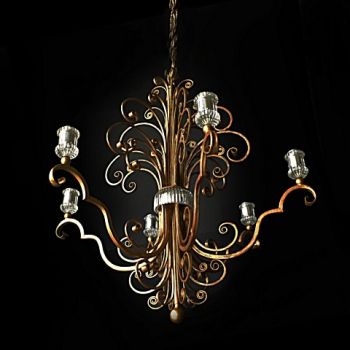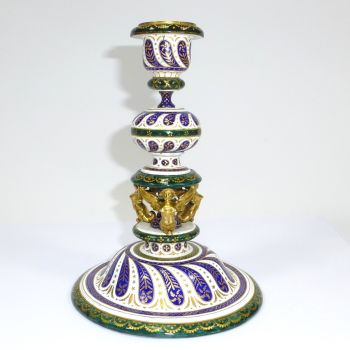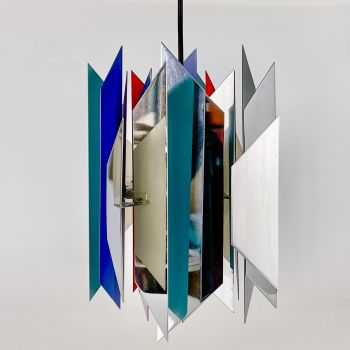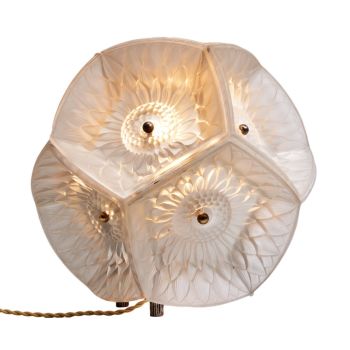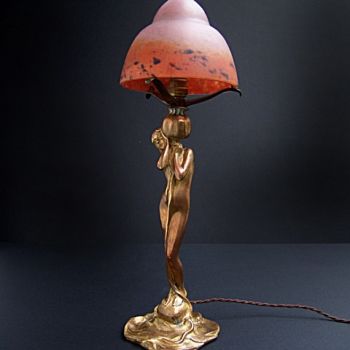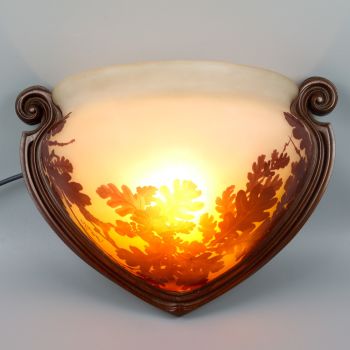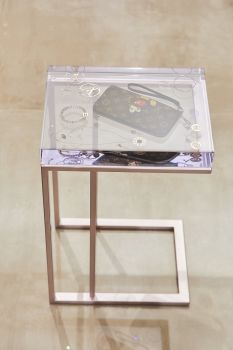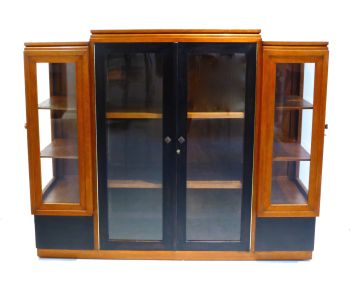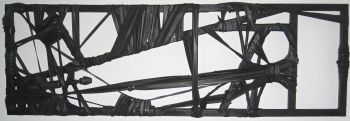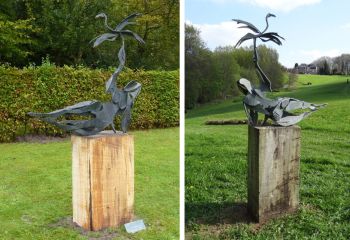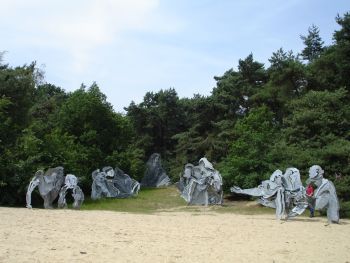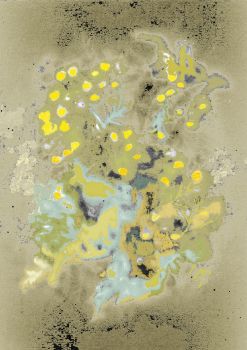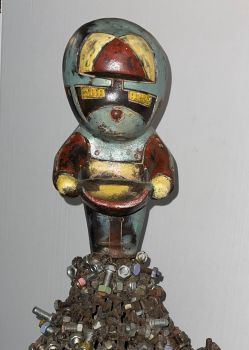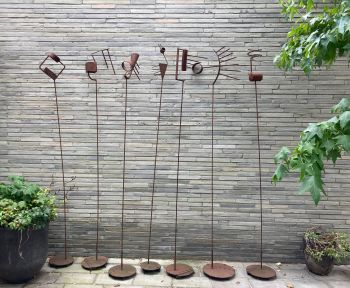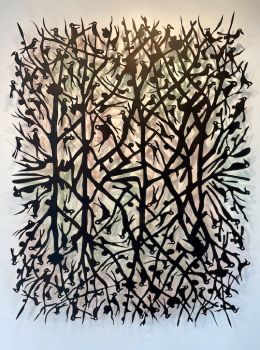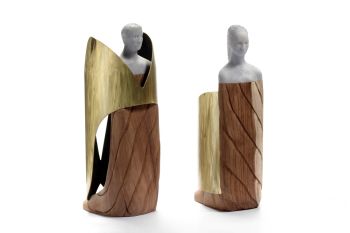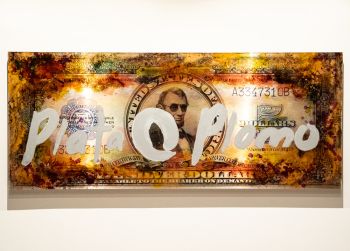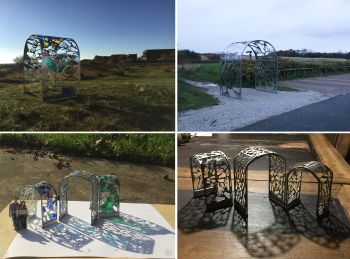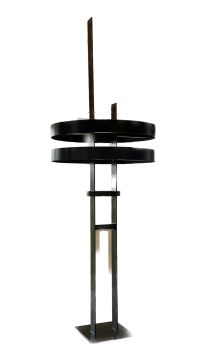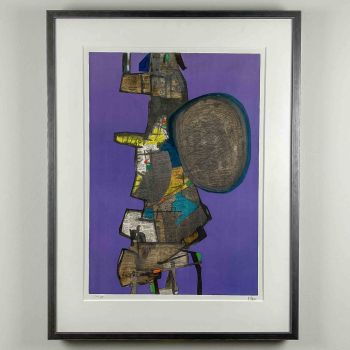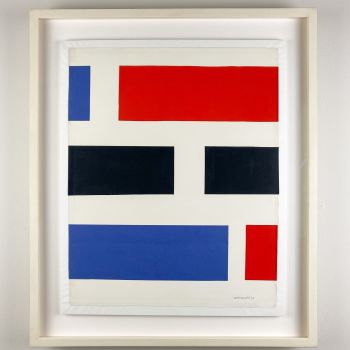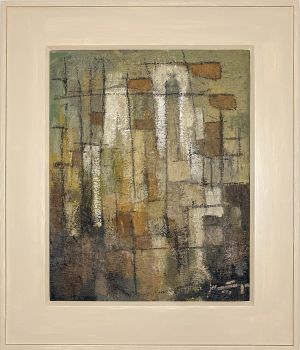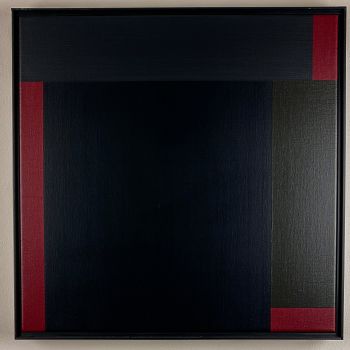Desk lamp, model 9227 – Idman, Finland ca 1955 1950 - 1960
Paavo Tynell
AluminiumStahlMetallBlechbläser
45 ⨯ 23 ⨯ 23 cm
ConditionVery good
€ 2.450
Van Kerkhoff Art
- Über KunstwerkA painted aluminium, brass and steel adjustable desk lamp with perforated shade, model 9227. Designed by the renowned Finnish lighting designer Paavo Tynell in the 1940’s and made by Idman Oy, Helsinki circa 1955.
The desk lamp has a round lacquered steel base. A brass rod is mounted on the base to which the lacquered perforated aluminium shade is connected. This connection is quite eleganty designed with a brass wing nut and is stamped “Idman Oy” in graceful lettering.
This desk lamp is in excellent condition, recently restored in it’s original condition.
About Paavo Tynell
Paavo Tynell (1890-1973) saw the light of day in Helsinki, twelve years after the introduction of the light bulb, at a time when Finland and most of northern Europe were still in the process of electrification. His birth marked the beginning of his journey to become a leading pioneer of modern lighting, in parallel with the spread of electric light around the world. By the year of his death in 1973, Tynell was entrenched as ‘the man who enlightened Finland’.
In his early years, it seemed unlikely that Tynell would become one of the most influential designers of his time. He was the seventh of nine children in a working-class family that could not afford further education for him after primary school. At the age of 16 he began his apprenticeship at G.M. Sohlberg’s metal workshop, where he worked as a sheet metal worker for six years before becoming a blacksmith for another year. During these formative years, Tynell created his first lamp fixturemade of brass, which would later become his signature material.
In 1918, together with his former teacher Ehrström, Tynell founded metal smith Frans Nykänen, sculptor Emil Wickström and industrialist
Gösta Serlachius the company Taito Oy. As managing director, Tynell led the production of various lighting fixtures, functional metal objects, sculptures and custom-made designs from the foundry of the company.
During the 1920s, Tynell was the principal designer at Taito, assisted by other talented designers and artists such as Alvar Aalto, Henry Ericsson and Ville Vallgren. By the 1930s Taito concentrated exclusively on lighting and played a crucial role in the growing electrification of independent Finland.
Internationally, Tynell enjoyed fame, with notable projects such as the lighting of the Parliament building in Helsinki, designed by architect Johan Sigfrid Sirén, and collaborations with leading modernist architects, notably Alvar Aalto.
The 1930s and 1940s were a period of experimentation for Tynell. His design style evolved from functionalist and art deco designs to more decorative and elegant expressions. During this time, he served as president of Ornamo, the Finnish association of industrial designers, where he supported and trained young designers. His influence extended extended beyond Finland, especially in the United States, where he almost
became a celebrity.
After World War II, Tynell returned to brass as his signature material, creating unique lamps that combined traditional aesthetics with a modern look.
Brass quickly became the signature of Taito, which now had about 150 employees. From the 1930s to the 1950s, Tynell was considered as Finland’s leading lighting designer and he was frequently asked to illuminate public spaces across the country,
particularly in Helsinki, where his lighting is still an integral part of the city structure.
His influence also extended internationally, especially in the US, where he achieved great success as a designer achieved great success. Taito’s merger with the lighting factory Idman Oy in 1953 led to Tynell’s retirement as director, but he continued to design for Taito and other lighting brands in Finland and abroad. His collaboration with the respected brand Lightolier in the US continued until 1966. Tynell’s legacy continues to shine, not only in Finland, but worldwide, as an icon of innovation in the world of lighting design.
Marked
Stamped Idman Oy
Execution
Idman Oy, Helsinki ca 1955
Condition
Very good condition. Complete restoration. Rewired. Wear consistent with age and use.
Literature
Ville Linna, Chasing Light: The Archival Photographs and Drawings of
Paavo Tynell
Charlotte and Peter Fiell, eds., 1000 Lights, Vol. 1: 1879 to 1959, p. 399
Dimensions
Height 45 cm
Width 23 cm
Depth 23 cm - Über Künstler
Paavo Tynell (1890–1973) war ein finnischer Industriedesigner und Meisterhandwerker, der für seine innovativen Beleuchtungsdesigns gefeiert wurde, die Funktionalität mit künstlerischer Eleganz verbanden. Bekannt als „der Mann, der Finnland erleuchtete“, spielte Tynell eine entscheidende Rolle bei der Gestaltung des modernen Beleuchtungsdesigns der Mitte des Jahrhunderts. Seine Werke, die sich durch ihre skurrilen und doch raffinierten Formen auszeichnen, sind heute ikonische Symbole des skandinavischen Designs.
Paavo Tynell wurde am 25. Januar 1890 in Helsinki, Finnland, geboren. Er begann seine Karriere als Metallschmiedlehrling, bevor er sich an der Helsinki University of Industrial Arts (heute Aalto University) einschrieb. Seine Ausbildung als Metallhandwerker beeinflusste seinen Designansatz zutiefst und gab ihm ein tiefes Verständnis für Materialien und Handwerkskunst.
1918 war Tynell Mitbegründer von Oy Taito Ab, einem Unternehmen, das sich auf hochwertige Metallarbeiten und Beleuchtungsdesign spezialisierte. Unter seiner Führung als Chefdesigner wurde Taito zu einem der renommiertesten Beleuchtungshersteller Finnlands. Seine frühen Entwürfe waren oft von komplizierter Metallarbeit und detaillierter Handwerkskunst geprägt, was seinen Hintergrund als Schmied widerspiegelte.
Tynells Durchbruch kam in den 1930er und 1940er Jahren, als er begann, modernistische Prinzipien in seine Arbeit zu integrieren. Inspiriert von der Natur fertigte er Beleuchtungskörper mit anmutigen, organischen Formen, wie perforierten Messingschirmen, zarten Blumenmotiven und luftigen, skulpturalen Elementen. In seinen Arbeiten kombinierte er oft Messing, Glas und Stoff, um Stücke zu schaffen, die sowohl funktional als auch optisch bezaubernd waren.
In Zusammenarbeit mit Architekten wie Alvar Aalto und der Innenarchitektin Aino Aalto wirkte Tynell an vielen bedeutenden Projekten mit, darunter öffentliche Gebäude, Hotels und Privathäuser in Finnland und im Ausland. Besonders bemerkenswert sind seine Entwürfe für das finnische Parlamentsgebäude und das Savoy Hotel in Helsinki.
Tynells Arbeit erlangte Mitte des 20. Jahrhunderts internationale Anerkennung. In den Vereinigten Staaten wurden seine Entwürfe von Lightolier vertrieben, wodurch seine charakteristische Mischung aus nordischer Handwerkskunst und Kunstfertigkeit einem weltweiten Publikum zugänglich gemacht wurde. Seine Stücke erfreuten sich aufgrund ihrer Eleganz und Vielseitigkeit großer Beliebtheit und wurden oft in hochkarätigen Inneneinrichtungen verwendet.
Paavo Tynell ging in den 1950er Jahren in den Ruhestand, doch sein Einfluss auf das Lichtdesign blieb bestehen. Seine Arbeit wurde im 21. Jahrhundert wiederentdeckt. Originale Tynell-Lampen erzielten bei Auktionen hohe Preise und inspirierten eine neue Generation von Designern. Zeitgenössische Marken wie GUBI haben einige seiner kultigsten Designs neu aufgelegt und so dafür gesorgt, dass sein Erbe weiterlebt.
Paavo Tynell starb am 13. September 1973 in Helsinki und hinterließ ein Werk, das die harmonische Mischung aus Kunst, Handwerk und Funktionalität veranschaulicht. Seine zeitlosen Designs bleiben ein Beweis für die Schönheit der finnischen Moderne und ihre anhaltende Anziehungskraft in zeitgenössischen Inneneinrichtungen.
Sind Sie daran interessiert, dieses Kunstwerk zu kaufen?
Artwork details
Related artworks
- 1 - 4 / 24
Børge Mogensen
Teak wood “dropleaf” desk – Søborg Møbler, Denmark circa 19551950 - 1960
Preis auf AnfrageVan Kerkhoff Art
Unbekannter Künstler
A rare Japanese export lacquer medical instrument box1650 - 1700
Preis auf AnfrageZebregs & Röell - Fine Art - Antiques
Unbekannter Künstler
A Dutch colonial Indonesian betel box with gold mounts1750 - 1800
Preis auf AnfrageZebregs & Röell - Fine Art - Antiques
1 - 4 / 24- 1 - 1 / 1
Firm Erhard & Sohne, Schwäbisch Gmünd
Erhard und Söhne – Jugendstil intarsia klok – 1908 / 19091900 - 1909
Preis auf AnfrageAntiques Emporium
1 - 4 / 24- 1 - 4 / 12































